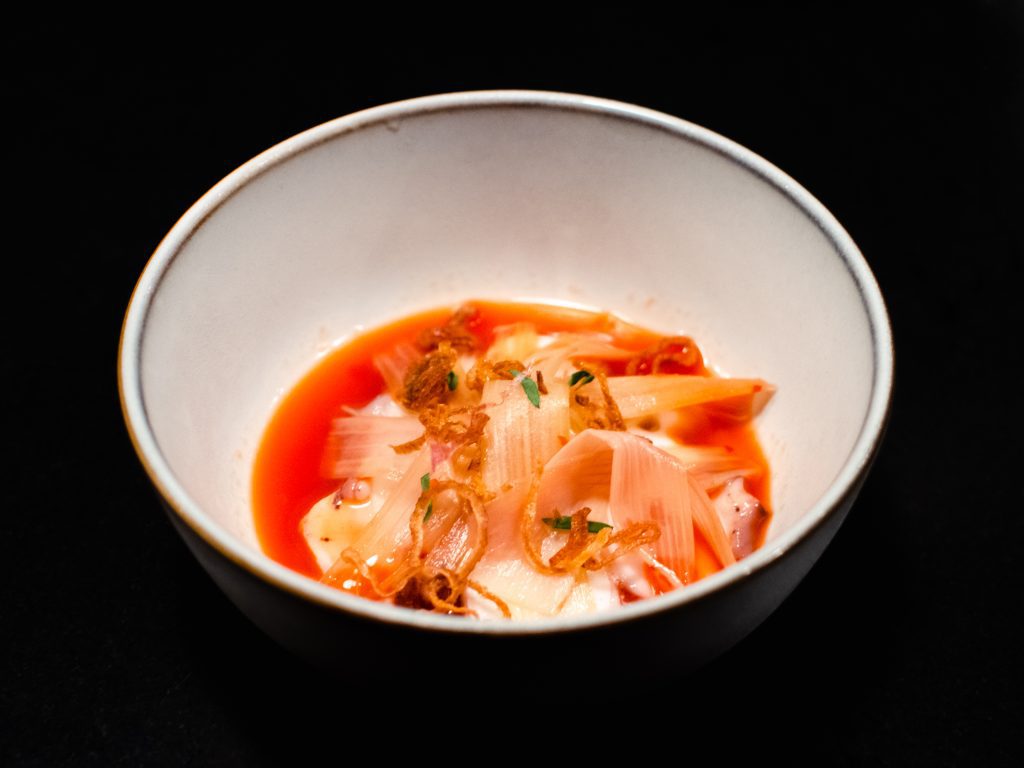July 2022 features Pristina Mok (previously from Restaurant Zén) with a challenge to incorporate local fishes in a seafood-based menu. My foray into fine-dining was set to a high bar at Magic Square.

Magic Square sits at one corner of a parking lot, a squat colonial building with its industrial kitchen peeking out through long windows, a beacon of light and warmth beckoning one in.
As we settled at our allocated seats, set in a L-shape around the kitchen; placed in front of us is a curated list of wines and sake. For the night, we had the Red Garnatxa, a fruity red as the partner for our dishes.
Everything lays exposed in the open kitchen, and you’ll see the synchronized dance performed as a backdrop as you consume each course. Each plate is prepared and served up to you at regular beats.

Geoduck – Lychee, daikon, lemongrass

The first course offered up Geoduck in a rich coconut broth, peeking out from the thin slices of pickled radish arrayed over pieces of clam. Rich flavours entered in-step with each bite. Geoduck mixed with sweet lychee chunks that burst with sweetness, all together in a creamy coconut emulsion below.
You can choose to mix up the tempo with your choice of utensils. Chopsticks allow each character to shine through clearly, while scooping up a bite with the spoon lets the coconut lead the dance with a different tune. At this point, we have thrown decorum out of the window, digging in with relish instead of daintily picking up each piece.
Octopus – belacan, rhubarb, peppers

The second course did not lessen in intensity. Nestled under the pile of sous-vide octopus is a dollop of ricotta and belacan chilli. Mixing both together gets you a creamy, spicy sauce. The richness of this pairing is given a brief hiatus with the tangy rhubarb, a pause before the flavours comes to the forefront once more. Rounding out the dish are the octopus slices, dragging out this pleasure with each chew.
A chat with Chef Pristina revealed that inspiration was had from the Korean Tteok-bokki with the use of seafood topped with cheese and chillies.
Petit Pois – tonggol, saint-nectaire, pine nuts

Longtail tuna that has been dried, condensing the flavour and a tough consistency. Minute chunks of bitter gourd. All settled afloat a cheese foam with pine nuts. The third course took a step in a different direction from the previous. Instead of sour notes, this dish brings about heavy salty flavours.
Kembong – flatbread, snakegourd, achar

With the previous course signalling a changeup, course four and beyond were savoury. The Kembong dish was a hands-on affair, where you were encouraged to pick up the flatbread and dive in. Three different elements present themselves; salty Mackerel that’s been charred, pickled, sweet archar all atop a flatbread.
Rice roll – garam masala, prawn stock, yam

The next course came with sides. A bowl of Keropok is set beside prawn broth with rice rolls. The stock, fortified with garam masala was then thickened to a curry-like consistency and hidden within each rolls is a mixture of mushrooms and yam. The flavour of the filling was hidden a little too well underneath the thick prawn sauce; thus the rice roll and fillings provide more of a textural component to this dish. Keropok is, to me, the superior carb for the dish. Dipping it into the savoury goodness gets you a crunch partnered with the umami-rich coating of the sauce.
Lingcod – turmeric leaf, dragon tooth vegetable, rempah

The star of the night. The stage was set with a cut of lingcod flavoured with the use of Rempah. Steeped below is a scattering of charred vegetables. Rempah, a south-east Asian spice paste storming in with a crash of flavour that complements the taste of the fish. Everything is then balanced out by the greens below, oddly refreshing despite having the hint of mala spice. Serve me up ten more plates of this and I’m good for the night.
Quail – corn, orange, broad beans

The discordant note among the rest of the seafood courses. A dish of Quail is served as the main course. Crisp skin, tender flesh seasoned to perfection, the seventh course was a well-prepared one. The choice of corn below reminded us of a rendition of grits leading us to think of the dish as a Singaporean take of the Southern grits with fried chicken.
Fenugreek – malt, liquorice, sesame

The arrival of dessert herald an interesting sight. Fenugreek jelly with sesame, and a serving of malt syrup (horlicks) placed alongside.

A shuffle to the tastebuds, each bite of the bitter jelly is offset by the sweetness of the syrup and the crunch of the cereal-like bits. An interplay of textures, balanced atop opposing flavours. Another crowd favourite.
Jasmine rice – nori, kueh kosui, rice wine

Bringing the event to a close is a monochromatic dish with a subtle yellow from the kueh kosui. The dessert offered different layers of sweetness in its components. As this dish was served, the kitchen’s energy has settled to an easy calm, the stainless steel tables have been wiped down and preparation for tomorrow’s service has begun. The aroma of roasted prawn heads filling the air.
Closing thoughts
Chef Pristina was kind enough to spare us some time, especially after what must have been a tiring day preparing out the courses to get our feedback, opinions, and answer any questions we might have.
Compared to the classic omakase, the diverse flavours and combination of ingredients used really differ. It was certainly unique and you can really see the experimental nature of the dishes coming through cleanly. I was concerned, with the initial dishes coming out with strong sharp flavours, that it will prevent us from appreciating the later few to their fullest potential. Something I understand is mitigated with Japanese omakase serving up dishes that are sequentially stronger in flavour as the courses progresses.
I really enjoyed the night. Price-wise, it came to around S$150 per person, including a glass of wine and still water together with the 9 courses. Certainly a steal. I would recommend everyone pay them a visit, not only to support the development of future chefs and Singapore cuisine beyond our hawker stalls but also in restaurants, but also to bear witness to how our local flavours can be showcased in a myriad of ways.
